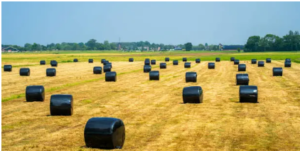In the vast and dynamic landscape of Australian agriculture, efficiency is paramount. Every step of the farming process, from cultivation to harvest, holds potential for optimisation. Among the array of technologies and methodologies employed by Australian farmers, the best quality silage wrap stands out as a key tool for maximising efficiency, particularly in the realm of feed preservation. Silage wrap technology has transformed the way farmers manage and utilise fodder, offering numerous benefits that contribute to the amazing sustainability and productivity of agricultural operations across the country.
 Silage, a fermented feed made from crops such as grass, maize, or sorghum, serves as a vital component of livestock nutrition in Australia. Ensuring the quality and longevity of hay is essential for maintaining the health and overall productivity of livestock herds. It is where silage wrap technology comes into play.
Silage, a fermented feed made from crops such as grass, maize, or sorghum, serves as a vital component of livestock nutrition in Australia. Ensuring the quality and longevity of hay is essential for maintaining the health and overall productivity of livestock herds. It is where silage wrap technology comes into play.
One of the primary advantages of silage wrap technology is its ability to create an anaerobic environment within the bale, inhibiting the growth of spoilage organisms such as mould and bacteria. This airtight seal prevents oxygen from infiltrating the bale, thereby preventing aerobic degradation and preserving the nutritional integrity of the hay.
In addition to preserving nutritional content, silage wrap technology offers significant advantages in terms of operational efficiency. Traditional methods of ensiling fodder, such as pit silage or bunker silos, require substantial labour and equipment for packing and covering the feed. Silage wrap simplifies this process by allowing farmers to quickly and efficiently wrap individual bales in plastic film using specialised machinery. It not only reduces labour requirements but also minimises the risk of contamination and spoilage during storage.
Furthermore, the compact nature of silage bales wrapped in plastic film facilitates easy handling and transportation. Unlike loose silage stored in pits or silos, wrapped bales can be conveniently stacked and stored in various locations across the farm, optimising space utilisation and streamlining feed management operations. This flexibility is particularly advantageous for Australian farmers, many of whom operate expansive properties where efficient use of space is essential.
Another notable benefit of the best quality silage wrap technology is its versatility across different types of forage crops. Whether it’s grass, legumes, or cereal crops, silage wrap can effectively preserve a wide range of feed materials, allowing farmers to diversify their silage sources and optimise nutritional profiles for their livestock. This flexibility enables farmers to adapt to changing environmental conditions and crop availability, ensuring consistent feed quality throughout the year.
Moreover, silage wrap technology offers environmental benefits by reducing waste and minimising the carbon footprint of agricultural operations. By preserving feed quality and minimising spoilage, farmers can reduce the amount of feed discarded due to degradation, thereby reducing waste and conserving resources.
The adoption of silage wrap technology has become increasingly widespread across Australia, driven by its proven effectiveness and tangible benefits for farmers. In addition to large-scale commercial operations, silage wrap has also found favour among smaller-scale producers and hobby farmers seeking to optimise feed management practices. As advancements in technology continue to improve the efficiency and affordability of silage wrap systems, their adoption is expected to increase further, contributing to the sustainability and resilience of the Australian agricultural sector.
To ensure that their operations run smoothly and efficiently, farmers must select the best hay-wrapping film. With so many options available, it can be challenging for farmers and contractors to determine which film is the right fit for their specific needs. The film they choose will impact how long the ensiled forage will last, the nutritional value of the fodder, and whether or not they can use the best baling equipment.
In conclusion, the best quality silage wrap technology plays a pivotal role in maximising efficiency and productivity in Australian agriculture. By preserving the nutritional quality of hay and streamlining feed management operations, silage wrap enables farmers to optimise resource utilisation, minimise waste, and enhance the sustainability of their operations. As the challenges facing the agricultural industry continue to evolve, innovative technologies like silage wrap will remain essential tools for meeting the demands of modern farming while ensuring the long-term viability of the sector.
